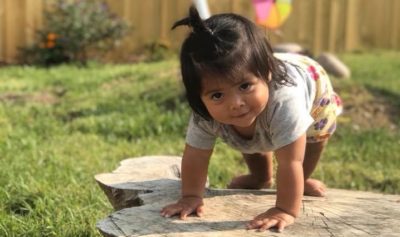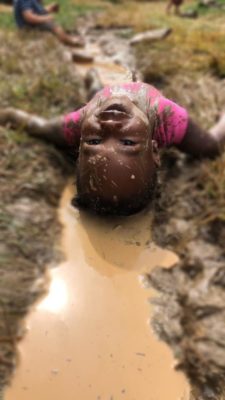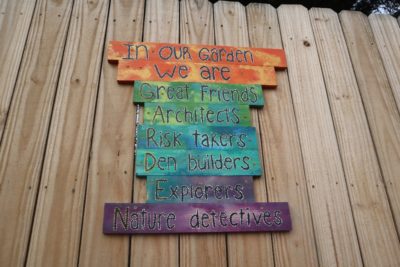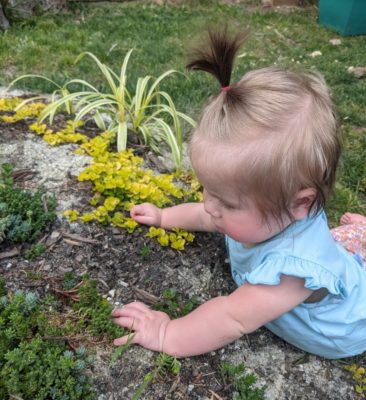Where Babies and Birds Play
How to Make a Nature Play Area at Home

When Vanessa Gilliam was growing up, she recalls outdoor play being a significant part of her childhood. As she became a professional childcare provider, however, she noticed that this was no longer the case for the next generation. Parents—and as a result, children—are scared of the outdoors. “I’ve seen that there are a lot of kids who don’t know how to play, much less know how to play in the dirt, or in nature.”
“When we were kids… we would play in the rain and snow, and catch frogs,” Vanessa says. She also reflects on a time when playing in the mud and getting dirty was encouraged rather than reprimanded. It was a different culture, and one that she hopes to bring back through advocating for the many benefits of natural play.
Learn more about Vanessa and Nessa’s Young’uns here.
What is Natural Play?

Natural play, according to Nessa’s Young’uns, is “[a] philosophy that captures how well young children learn through movement and doing in the natural world”. One of the many benefits of natural play is known to include increased attention span. Speaking from her research and personal experience, Vanessa says,
[Children] tend to stay engaged a lot longer in the outdoors, with fresh air and open space.
In a time when attention disorders run rampant, natural play could take on an important role in managing these neurobehavioral issues.
The benefits of natural play are nothing new, though—its something we can see even in adults. “Adults experience very frustrating days, whether it is from work or personal reasons, and they tend to seek the outdoors as a release… [they seek] a place to take a deep breath like the back porch, backyard, garden, or just a walk, whether they realize it or not.”
Children are no different, Vanessa says. “They experience very frustrating days from something as simple as teething to sadly even more extreme family situations and they need a place to release, feel comfort, and/or to take a deep breath.” The outdoors provides an outlet that can calm the mind and promotes a healthier mental state.

Natural Play and Child Development
How much can a child learn by playing with a daisy? They pick the daisy and look at it. They pluck the petals off and count, 1, 2, 3. They see the daisy growing in the dirt and learn that flowers have leaves. They talk to you about the daisy. They can learn a lot.
The developmental domains include physical, cognitive, communicative, socioemotional, and adaptive. All of these domains, Vanessa has learned through her research, tend to be easily checked off through natural play.
“They learn through their senses… they get to hear birds, they get to feel the wind, they get to feel the rain on their face, and mud on their toes. They get to pull the petals off a flower.”
Nessa’s Young’uns is not alone, luckily, in it’s advocation for natural play and child development. The childcare center bases its philosophies off of well-researched and supported information provided by the National Association of Education for Young Children. “Time spent outside can lead to better physical and mental health, improved sleep, and cognitive, social, and emotional gains for young children,” the NAEYC says. “A trip outdoors might feel like too much hassle… But outdoor play is worth the time and effort.”
To learn more about the developmental domains, check out this guide from Expert Community Care Management. For more information on how these developmental domains are specifically impacted by natural play, check out this publication from the National Association of Education for Young Children.
How to create a natural play area (in your own backyard)
Where to Grow
Creating a designated spot where kids are allowed to pick flowers, plants, etc., and then a place where they may only look at the plants is a good guideline for creating a natural play area. This not only creates a fun, outdoor play area, but it also teaches boundaries and how to respect nature.
What to Grow
One specific plant that Vanessa recommends parents planting is a birdhouse gourd. While these gourds are non-native, they are not invasive and can be easily contained in the backyard. The vine of birdhouse gourds has huge leaves that can easily create a green corner for kids to play in.

Even better? Birds also love this gourd, hence the name. The plant is attractive to a diverse array of species, including bluebirds, wrens, woodpeckers, chickadees, finches and swallows. When the gourds are fully grown and ready to harvest, you can construct your very own gourd birdhouses. Not only will you create a fun natural play area for kids, but also an ideal backyard habitat for a variety of birds.
For more guidance on how to make a gourd birdhouse, check out this guide from the Natural Resources Conservation Service.
The greatest part about this plant, Vanessa says, is that it can grow almost anywhere. No backyard required. It can be grown on balconies, porches, or anywhere that has sunlight. And after the gourds dry out, you can collect the seeds to plant for next year and start all over again.

Some additional plants that are durable and ideal for natural play areas are native mosses and liverworts. Textured plants like these can encourage sensory learning through touch. Species of herbs such as spearmint, lavender, and rosemary are beneficial to plant as well, as they let off an aroma—and a taste— that engages sensory exploration.
For a full list of suitable species to put in your natural play area, head to Stepables to search for plants by category.
Why Encourage Natural Play?
Regardless of the developmental benefits of natural play, Vanessa says that there is a much deeper reason for encouraging this practice that goes beyond scientific reasoning. “These children are the Earth’s future… if they don’t love nature, then how are we going to protect it?… If they don’t learn to appreciate it and respect it, where is the earth going to be when they’re older?”
Interested in improving habitat where you live? We offer seasonal tips on how to make your yard and home a better habitat for native plants, animals, and insects. Explore more Habitat at Home topics here. You can also sign up for Conserving Carolina emails to get the latest Habitat at Home columns in your inbox.
Author Allison Houtz is serving as an AmeriCorps Project Conserve Communications and Education Associate with Conserving Carolina.